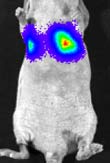Glow-in-the-Dark Creature to Provide View Inside Human Body

Tiny semiconductor crystals called quantum dots may soon light their own paths through the human body. Scientists are splicing modified proteins from a glow-in-the-dark ocean creature onto the microscopic semiconductors to make self-illuminated dots.
Quantum dots, which are 10 to 50 or so atoms wide, have been around for at least two decades. Although scientists have high hopes for the dots in fields such as super computing, most current applications cash in on the dots' optical characteristics. Because quantum dots light up, or fluoresce, when struck by narrow bands of light energy, they are especially useful for medical imaging.
Like other current biomedical imaging technologies that illuminate nanoparticles, such as gold flecks, most quantum dots light up only when an external energy source, such as laser, strikes and excites them. Relying on external light stimulation causes a couple of problems. Light from the source cannot reach very deep into tissue. And even in areas the source can penetrate, the light bounces off tissue, clouding the picture the way oncoming headlights diffuse on a rain-streaked windshield.
Nanoparticles that make their own light could skirt such issues and help medical technicians take clearer pictures from deeper inside the human body.
Help from a pansy
At Stanford University scientists have joined quantum dots to glowing proteins. The proteins themselves aren't imaged. Instead they release bioluminescent energy that excites the dots to glow red. Effectively, each dot carries its own energy source on board.
The original enzymes—specialized proteins that accelerate chemical reactions—are from the sea pansy, a mushroom-shaped colony of polyps with a large stem that anchors the colony in sand. When sea pansies are disturbed, they shine brightly.
Sign up for the Live Science daily newsletter now
Get the world’s most fascinating discoveries delivered straight to your inbox.
"They have a light-emitting protein, a bioluminescent protein, amino luciferase," explains Jianghong Rao, an assistant professor in radiology at Stanford.
This protein is similar to those in other glowing creatures, such as jellyfish and fireflies, he says. In fact the scientists first tried firefly luciferase, but it proved too fragile.
Shining brightly
The scientists made a more stable, brighter protein that they based on the sea pansy luciferase. Then they chemically connect this modified protein to the dots. Mixing the modified quantum dots with a catalyst, coelenterazine, starts the glowing chemical reaction. Once the on-board energy source is triggered the dots shine for about 15 minutes, with their peak brightness coming after about five minutes, Rao says.
To compare the self-illuminating dots with conventional quantum dots, the researchers injected each type deep into the shoulders of mice, one type per shoulder. Next they injected coelenterazine into the tail. When the modified dots met the catalyst, they began to glow. The scientists then used fluorescence imaging devices to try to track both kinds of dots.
"We could see the bio-luminescence imaging from either side," Rao says. "But if we used the original fluorescence imaging, then we couldn't see them at all."
Editor's Note: In the image at the top of this page, the protein-laded nanoparticles glow red on the right shoulder of a mouse. Credit: Standford University









